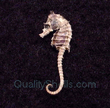What are "flying fish," and can they really fly? |
Site NavigationHome PageArticles Where do shells come from? Is seawater similar to blood? Picking up seashells What are starfish? Do sharks have skeletons? What are sand dollars? What are seahorses? What are "flying fish"? How navigate on the ocean? More legs than an Octopus? Fish training Can I drink seawater? Additional Resources Seashell Identification Guide Conchologists of America Waikiki Seashells Training Fish Featured Products Marine GPS with MOB Key Privacy Policy Page Contact Us |
What are "flying fish," and can they really fly? They really do "fly" through the air. Flying fish have enlarged winglike fins used for brief gliding flight. They have a pair of those fins just behind the head, and in some varieties another pair nearer to the tail. They generally don't flap those fins, just hold them steady and glide. The four-winged versions can glide farther than the two-winged types, sometimes for 200 meters or more, especially if they can ride on the updrafts coming off of the front faces of waves. Flying fish use their gliding ability to evade predators by leaping from the water and gliding through the air faster than they could swim through the water, beginning with a strong "kick off" from their tails as they enter the air. Some types will, on slowing down, drop their tails back into the water for another push and speed up again. It's reported that the hatchetfish of the Amazon actually does beat its pectoral fins and flies for short distances. If a predator -- a larger fish such as a tuna or swordfish, for example -- was following close behind, it wouldn't be able to see them while they were in the air due to reflection of light back from the water's surface. "Flying" is a great escape method for a fish! They can almost double their "through the water" speed while in the air, reaching speeds up to 60 kilometers per hour. Flying fish are mainly found in warm tropical waters in many oceans. They are normally found near the surface. They mostly aren't very big, ranging from 13 to 46 centimeters in length. Any larger and they'd be too heavy to "fly". Most are small-mouthed and eat plankton and other very small organisms. In areas where flying fish are common, so is the situation of finding them stranded on the decks of boats! They glide in over the top of a boat's deck, hit part of the superstructure and stop, and are stuck there. While most fishes have curved corneas, flying fishes have flattened corneas to let them focus their eyes properly both in and out of the water. It's sort of like a human wearing a scuba diving mask to keep his vision from going blurry when underwater. Nature never ceases to be amazing. |
 Murex Ramosus Seashell  Seahorse  Sand Dollar  Pearl Nautilus Seashell -- Split  Jungle Starfish  Lambis Chiragra Spider Conch Seashell |